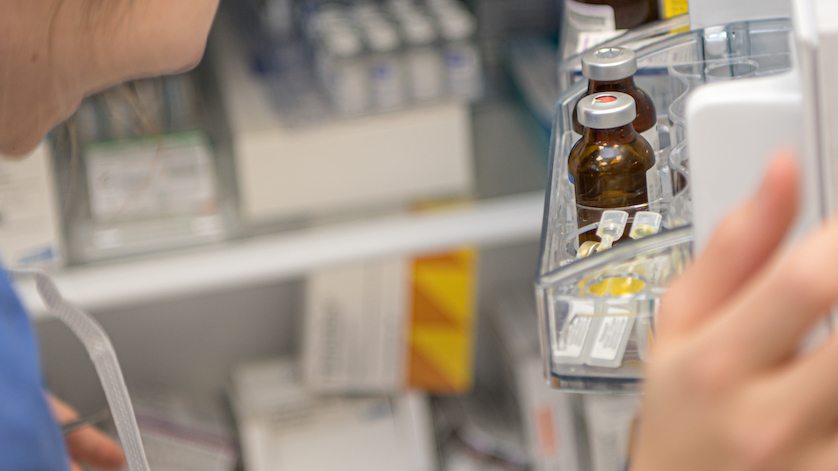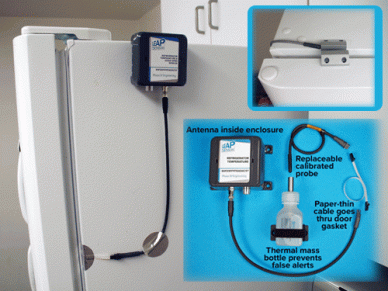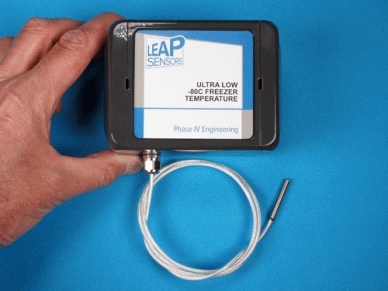
Temperature-sensitive products like COVID-19 vaccines call for failsafe cold storage units. Phase IV Engineering, a WIKA partner, offers wireless temperature monitoring systems that easily attach to a facility’s existing refrigerators, freezers, or ultra-low freezers.
Anyone who has kept up with the news knows that certain COVID-19 vaccines are extremely temperature-sensitive. If vials are left out too long at room temperature or even above 5°F/−15°C (for Pfizer-BioNTech), the vaccine degrades and must be discarded.
In fact, all vaccines require cold storage. Some must be kept in regular or ultra-low freezers, while others are compromised if the temperature drops below freezing. And of course, vaccines should not thaw and then refreeze.
Temperature Monitoring for Vaccines and Other Sensitive Products
According to the CDC’s latest Vaccine Storage and Handling Toolkit, an effective cold chain has three components: well-trained staff, reliable storage and temperature monitoring equipment, and accurate inventory management. Guidelines for cold storage monitoring include:
- A temperature monitoring device (TMD) that records all temperatures at preset intervals, not just the daily max and min, and to keep the data for at least three years. This TMD must be highly accurate. The CDC recommends a digital data logger.
- Protect the cold storage unit’s power supply. This means making sure the unit is not accidentally unplugged or has its fuse tripped.
- Safeguard the door. An open door not only raises the refrigerator or freezer’s internal temperature, but it also allows light to enter, which could lead some vaccines to degrade.
Other sensitive items also require accurate temperature monitoring. Many biological products – reagents, lab samples, insulin, tissue samples, etc. – are stored at cold and ultra-cold temperatures. And to a lesser degree, but no less critical, frozen and refrigerated food stock need to be monitored almost as carefully. A door left open or a power outage is not only a health hazard but can also be costly, so accurate tracking and monitoring is crucial. To ensure product effectiveness and safety from manufacturing plants to the end user, storage units must be able to maintain a steady temperature.
Some pharmaceutical-grade units are equipped with continuous monitoring systems that meet CDC guidelines and industry best practices, but what do you do if your cold storage unit doesn’t have these features built in? You need a simple yet sophisticated temperature monitoring system.
Breakthrough Ease and Reliability in Cold Storage Monitoring
WIKA has a majority investment in Phase IV Engineering, a company that offers remote sensing and IIoT (Industrial Internet of Things) solutions. Their monitoring system works seamlessly with your existing refrigerators and freezers, whether they are household-grade units or equipment purpose-built for vaccine storage.

Leap Sensors wireless temperature monitoring system
Based on Leap Sensors®, the company’s wireless monitoring system for refrigerator/freezer is for temperatures down to −40°C/°F. Its advantages over other systems:
- A paper-thin cable from the sensor transceiver node to the probe, for gasket seal integrity.
- Software interface to almost any software, either on-site or cloud-based. Phase IV also offers its own SensorManager.com software.
- Bi-color LEDs integrated into the power switch blink to provide user feedback on sensor functions.
- Edge computing (at the sensor level) calculates weighted averages to determine if a reading is truly out-of-spec, eliminating false alarms.
- Easily replaceable NIST-traceable tip (optional) for simple calibration.
- Plug-in wall transformer (optional) to power the sensor and also to alert of power outages.
- Comes standard with a long-lasting onboard battery. With the plug-in option, this battery acts as a backup power source.
- Door-open sensor (optional) to track how long a door is open, which helps troubleshoot alerts.
Other key features:
- Digital datalogging automates tracking and reporting.
- Alerts sent by phone, text, and/or email for off-site monitoring – know immediately if there’s a problem.
- Thermal mass bottle (optional) prevents false alarms from defrost cycles or when the door is opened.

Ultra-cold freezer wireless sensor
For a sensing range from −85°C to −60°C (−121°F to −76°F), use the wireless sensor system for ultra-low temperature freezer. Advantages of this system include:
- Edge computing (at the sensor level) calculates weighted averages to determine if a reading is truly out-of-spec, eliminating false alarms.
- A 3-point temperature verification with a ±1°C accuracy in the −80°C to −50°C range.
- Door-open sensor (optional) to track how long a door is open, which helps troubleshoot alerts.
Pre-configured sensor settings and various mounting options make these systems fast and easy to install. Both are ideal for temperature-critical applications in labs, medical facilities, and vaccine/medication storage, as well as for food storage. If one of these systems does not meet your exact requirements, the Leap Sensors system’s modular design is easy to customize.
These temperature sensor systems are part of the breakthrough Leap Sensors wireless sensor monitoring system. Its advanced design makes it easy to monitor critical equipment and processes – and know ahead of time where a problem might occur. With modular, multi-sensor technology that is easy to install and update, Leap Sensors meets the specific, demanding needs of industrial and enterprise users.
For hospitals and clinics, temperature excursions are costly, time-consuming, and potentially dangerous to human health. A reliable temperature monitoring device with digital data logging is well worth the investment. Contact Phase IV for more information about temperature monitoring systems that safeguard your vaccines and medications.

